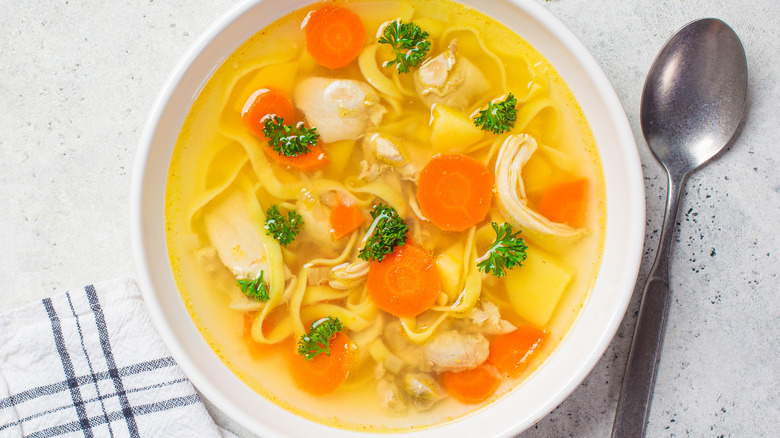Can Chicken Soup Help A Cold?
Chicken soup has long been touted for its ability to help fight the common cold, but is this really true, or is it just another myth? Believe it or not, it's more accurate than you might think. While chicken soup can't actually cure your cold, it can certainly help relieve some of your more unpleasant symptoms (via CNN). That's because chicken soup is hot, aromatic, and full of nutrients. Studies have shown that chicken soup can help thin mucus, clear nasal passages, and soothe a sore throat.
Chicken soup is also high in protein and essential vitamins and minerals. In fact, it's a great source of vitamin A and zinc, both of which can help boost your immune system. "Chicken soup can offer a nutrient-dense food option when someone is struggling with a poor appetite," Kristen Smith, a registered dietitian and spokeswoman for the Academy of Nutrition and Dietetics, told CNN. "It can also help increase hydration during a time when this could be a challenge."
Chicken soup contains immune-boosting ingredients
It's the ingredients, however, that give the soup its immune-boosting properties. Aside from the more typical ingredients of chicken, carrots, and celery, adding garlic and onions to your chicken soup can greatly improve its nutritional content and help relieve your symptoms (via Elite Daily). "Garlic contains allicin, a phytochemical that has antibacterial properties," registered dietitian Chrissy Brissette told Elite Daily. "It's been used for centuries by many cultures as an immune system booster." Raw garlic can also help improve your immune function.
Furthermore, using a bone broth for your chicken soup can help boost your electrolytes, which can help keep your body hydrated. In fact, bone broth contains sodium, calcium, magnesium, phosphorous, and potassium — five of the most important electrolytes. Although it can sometimes feel difficult to eat when you're sick, eating a nutritious bowl of hot chicken soup can give you the energy and nutrients you need to help fight off your cold.


